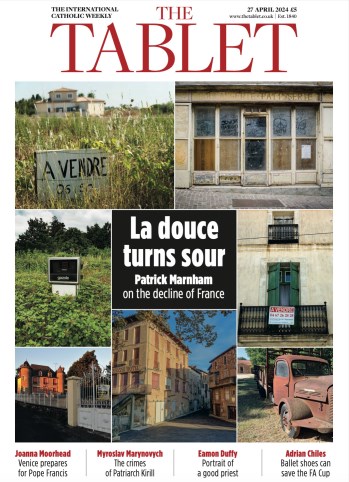Reviewed by David Goodall
WILLIAM COLLINS, 416pp, £25)
Tablet bookshop price £22.50
Tel 01420 592974
In the last few years, there has been no shortage of excellent books about post-independence India, among them Patrick French’s India: a portrait, Mark Tully’s India: the road ahead and, perhaps the most comprehensive, Ramachandra Guha’s India after Gandhi. John Keay’s Midnight’s Descendants is a valuable addition to this list, not least because, while focusing mainly on India itself, it traces at the same time the parallel history of India’s closest neighbours, Pakistan and Bangladesh, as well as Nepal and, to a limited extent, Sri Lanka – all of which, in different degrees and for better or worse, have helped to shape the character of India as it is today. His title (like Salman Rushdie’s Midnight’s Children) is taken from Pandit Nehru’s famous independence day speech (“At the stroke of the midnight hour, when the world sleeps, India will awake to life and freedom …”), and Keay is a skilful and objective guide through the subsequent maze of triumphs, disasters, misjudgements, failures and successes that have produced today’s five precariously stable and currently democratic states which by 2020 (as the publisher’s blurb tells us) will together comprise a quarter of the world’s entire population.
The main features of his story are familiar: Partition itself, with Mountbatten’s controversial decision to advance the date, and the carnage which followed; the tangled and still dangerously unresolved problem of Kashmir; Pakistan’s inherent instability and its “re-partition” into Pakistan and Bangladesh; the fissiparous character of India itself, with its Hindu-Muslim divide, its partly ill-defined frontiers and its (allegedly) 80,000 distinct “cultural and ethnic identities”; the almost inconceivable scale of subcontinental poverty; Nehru’s admiration for, and adoption of, Soviet-style central planning and its stifling economic consequences; the hollowness of India’s proclaimed non-alignment: its “hegemonistic mindset” in relation to its neighbours; the fatally dictatorial proclivities of Indira Gandhi; the remarkable persistence of parliamentary democracy in India, and its chequered history elsewhere; the dramatic economic advance of the past 20 years; and the important role in India’s recent economic growth played by the Indian “diaspora” and the NRIs (non-resident Indians).
Keay’s history contains no new or startling facts: but building them into a single narrative, and tracing Pakistan’s (and Bangladesh’s) troubled history alongside India’s, gives a perspective on the sub-continent which more narrowly focused studies, or contemporary reporting, of their nature cannot convey. A factor which stands out from the beginning is the radically unsettling effect of Pakistan’s constitutional unreadiness for independence in comparison with India’s; its establishment on the basis of a principle – that religious identity is a sufficient basis on which to build a national identity – that strikes at the heart of India’s precarious national cohesion; and its subsequent succession of weak governments punctuated by military coups (although Field Marshal Ayub Khan appears as one of its most tolerant, effective and initially successful rulers).
Given the extent and complexity of the ground covered in a book of just over 400 pages, occasional omissions or oversimplifications are unavoidable. Keay is sparing in his value judgements, but I think he somewhat understates the harm done by Nehru’s “licence permit raj” in terms of inhibiting private enterprise and discouraging much- needed foreign investment, and above all in fostering the spread of corruption which has become the scourge of modern India. Keay refers to Rajiv Gandhi’s estimate that 85 per cent of all development funds were pocketed by corrupt officials, but otherwise takes insufficient notice of the prevalence of corruption at every level of life in India and its malign effect on Indian politics and the quality of governance. I think he also underestimates the extent of the shock to India’s self-understanding of the sudden collapse of the Soviet Union, which until then had been to a significant extent both its economic model and its guarantor against Western and Chinese pressure; and the external factors (notably the first Gulf War and the prescriptions of the IMF) which forced Narasimha Rao’s Government to accelerate the dismantling of the “licence permit raj” in 1991.
Keay does not deal with the Afghanistan imbroglio, except to observe drily that “the Pakistani nightmare of India being accorded a prominent role in Afghanistan will surely be discounted once the Taliban secure a share in the country’s government”. Completed before the results of the recent election in India were known, Keay views with understandable dismay the growth of aggressively militant Hinduism, of which elements in the Bharatiya Janata Party (BJP) led by Narendra Modi – victors by a landslide in the recent election – are the political expression, but he has little to say about the deeper causes of this phenomenon, or indeed about the impact on traditional culture, whether Hindu or Muslim, of economic progress and Western-style consumerism. At the same time, he acknowledges that India’s last BJP-led Government (1998-2003) was unexpectedly pragmatic, economically successful and (towards Pakistan) pacific; and his prediction for the immediate future of the subcontinent as a whole is surprisingly, if very cautiously, optimistic. With Modi being sworn in as India’s new Prime Minister in Delhi this week in the presence of the Prime Minister of Pakistan, Nawaz Sharif, the first time since “midnight’s children” won their independence that a prime minister from one state has attended such a ceremony in the other, the reader of this knowledgeable, elegantly written and broadly dispassionate history will be tempted to agree.



 Loading ...
Loading ...
What do you think?
You can post as a subscriber user...
User Comments (0)